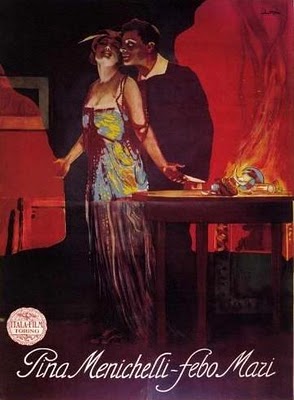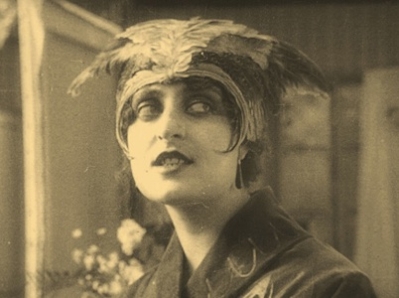Many a patriarchy has tried (and failed) to paint women as the weaker sex. In fiction -- as in real life -- plenty of women have proven themselves to be capable of amazing things:
- Biblical characters such as Jochabed, Salome, Delilah, and Esther knew how to think strategically.
- Fictional characters such as Medea, Elektra, Lady Macbeth, and Marian Paroo all knew how to get results by taking matters into their own hands.
- Powerful rulers such as Cleopatra, Elizabeth I, Queen Victoria, and Catherine the Great were forces to be reckoned with. Like Joan Crawford, Prime Minister Margaret Thatcher's credo might well have been "Don't fuck with me, fellas!"
Whether seen as gods or mortals, women such as Joan of Arc, Brünnhilde, Floria Tosca, and Xena the Warrior Maiden will fight for what they believe is right. Others have a strange, mischievous appeal. Consider how women are portrayed in this 1909 silent short entitled Princess Nicotine, or The Smoke Fairy by J. Stuart Blackton (the founder of Vitagraph Studios and father of animation).
On stage and screen, women have been depicted as sex magnets whom men are helpless to resist. Beauty, however, is in the eye of the beholder. While some men may favor Marilyn Monroe, others are drawn to dames like Daphne (Robert Morse) and Josie (Tony Roberts), who boast of having "The Beauty That Drives Men Mad."
The California Milk Processor Board recently caused a stir with a controversial new version of its famous "Got Milk?" advertising campaign by attempting to position milk as a tool for ameliorating the worst effects of premenstrual syndrome.

Poster art for "Got Milk?"
Surprised by the outcry over the ad campaign's bad taste and sexist tone, a spokesperson for the California Milk Processor Board issued a statement saying that
Over the past couple of weeks, regrettably, some people found our campaign about milk and PMS to be outrageous and misguided -- and we apologize for those we offended. Others thought it funny and educational. It has opened up a topic that affects women, of course, but also relationships.
Just think about the difference one single letter of the alphabet can make. Imagine if the following ad had been created for men who suffer from PME (premature ejaculation) instead of PMS?
* * * * * * * * * *
Sexual cannibalism is a routine part of nature. The female praying mantis is known to bite the head off of its male partner; the black widow spider frequently eats its partner after mating.
The myth of the deadly diva is as old as the hills. From biblical temptresses to blood-sucking vampires, from the sirens of Greek mythology (whose seductive singing lured many a sailor to his death) to the succubi who appear in men's dreams, women have been portrayed as man-hungry predators throughout the history of literature. Numerous folk tales warn of the danger faced by those men unlucky enough to encounter a woman who possesses a ferocious vagina dentata.
Last year's San Francisco Silent Film Festival offered fans an extremely rare treat: a screening of Giovanni Pastrone's 1916 masterpiece, Il Fuoco. Starring Pina Menichelli (whose overwrought style of acting earned her the nickname "Our Lady of the Spasms") as an egomaniacal diva and Febo Mari as the young painter she ensnares in her charms, Il Fuoco had audiences gasping in amazement and laughing their heads off at the diva's outrageous behavior.

Poster art for Il Fuoco
Cast as a poet, Menichelli often looks as outrageous as a lionfish. According to the program note by Linda Williams:
Pina Menichelli's diva is pure, unadulterated femme fatale. Like most divas of the Italian cinema of this era, she moves sinuously and elegantly, giving herself more to the camera than to the man she seduces. But unlike many of the other divas, in this role she is untouched by fatal disease, uncanny apparitions, or even by a blemished reputation. For once, the woman is as much an artist as the man. She is a practiced predator. Her owl headgear, clenched teeth, and parted lips reveal an animalistic instinct to hunt, but not to devour her prey. Rather, her pleasure is to pounce on her little field mouse of a painter, toy with him, and then toss him away. After she orchestrates his creation of a masterpiece with her as its subject -- a daring and kitsch nude portrait modeled on Cabanel's 'The Birth of Venus' -- she will have no further use for him.
Bypassing the familiar spectacle of female suffering but not, as might be expected, by turning to any consequent pathos for the male, Il Fuoco offers the pleasurable spectacle of a diva whose only love is herself. Menichelli's poet takes pleasure in her own taking of pleasure. Pleasing herself despite a pronounced disdain for her pleasure's ostensible object, she performs a very pure kind of narcissism. All her seductive movements are activated by a counterforce that simultaneously pushes away what she must nevertheless attract -- if only in order to be able to throw it away and exalt in herself alone. To watch Menichelli quickly seduce her young field mouse and then just as quickly get rid of him is to truly understand the counterforces of attraction and repulsion.

Pina Menichelli is a narcissistic diva in Il Fuoco
Co-presented by Istituto Italiano di Cultura di San Francisco, the screening was accompanied by Stephen Horne on piano with soprano Jill Tracy supplying a sultry style of moaning "siren sounds." Because this print (courtesy of Museo Nazionale del Cinema, Torino) came with titles in Italian, Frank Buxton read from an English translation in crucial moments. It's safe to say that, whether taking the film seriously or relishing its moments of high camp, the audience inside the Castro Theatre had a rollicking good time.
* * * * * * * * * *
As he began to introduce The Woman Men Yearn For, film critic Leonard Maltin suggested that it's time people stopped using the term "femme fatale" as their default for describing characters like those portrayed onscreen by Marlene Dietrich. His point, quite simply, was that these women do not aggressively seek to destroy men. Many of them, in fact, do absolutely nothing to instigate the demise of the men who are attracted to them.
Perhaps that's because characters like Frank Wedekind's deadly Lulu are not merely unaware, but also confused by the power their beauty and/or sexuality exerts over men. Maltin prefers to call such women "intrigants" because of their strange capacity to intrigue others. When Dietrich makes her first appearance in this film, staring out of the window of a railroad car, her stare is riveting. The power of her screen presence is inescapable.

Poster art for The Women Men Yearn For
This article was cross-posted on My Cultural Landscape. To continue reading, click here.
To read more of George Heymont go to My Cultural Landscape
